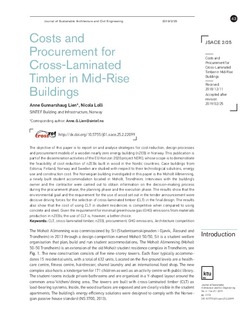| dc.description.abstract | The objective of this paper is to report and analyse strategies for cost reduction, design processes, and procurement models of one wooden nearly Zero Energy Building (nZEB) in Norway. The building investigated in this paper is the Moholt Allmenning, a newly-built student accommodation located in Moholt, Trondheim. Interviews with the building's owner and the contractor were carried out to obtain information on the decision-making process during the procurement phase, the planning phase, and the execution phase. The results show that the environmental goal and the criteria set for the use of wood in the tender announcement were a critical driving force for choosing cross laminated timber (CLT) in the final design. The results also show that the cost of using CLT in student residences is competitive against using concrete and steel. Given the requirement of little greenhouse gas (GHG) emissions from materials production in nZEBs, the use of CLT is however a better choice.
The objective of this paper is to report and analyse strategies for cost reduction, design processes, and procurement models of one wooden nearly Zero Energy Building (nZEB) in Norway. This publication is part of the dissemination activities of the EU Horizon 2020 project NERO, whose scope is to demonstrate the feasibility of cost reduction of nZEBs built with wood in the Nordic Countries. Case buildings from Estonia, Finland, Norway, and Sweden are studied with respect to their technological solutions, energy use, and construction cost. The Norwegian building investigated in this paper is the Moholt Allmenning, a newly-built student accommodation located in Moholt, Trondheim. Interviews with the building's owner and the contractor were carried out to obtain information on the decision-making process during the procurement phase, the planning phase, and the execution phase. The results show that the environmental goal and the criteria set for the use of wood in the tender announcement were a critical driving force for choosing cross laminated timber (CLT) in the final design. The results also show that the cost of using CLT in student residences is competitive against using concrete and steel. Given the requirement of little greenhouse gas (GHG) emissions from materials production in nZEBs, the use of CLT is however a better choice. | nb_NO |
